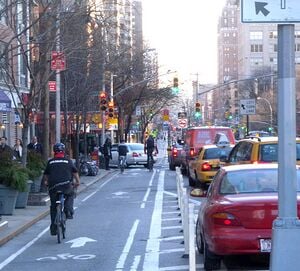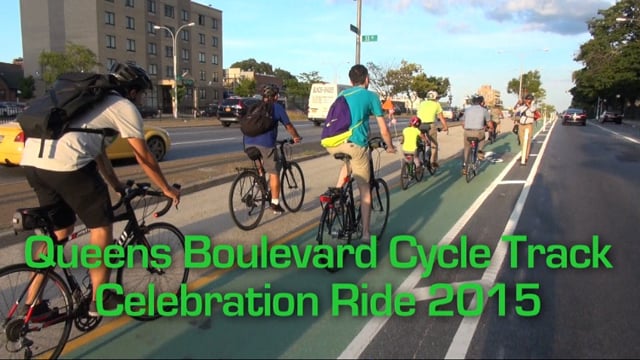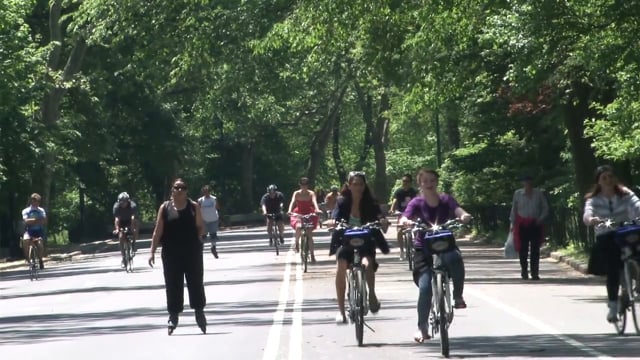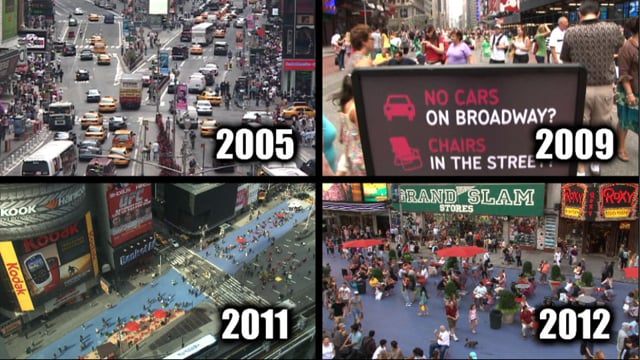
This page is the beginnings of a portal for New York City community action in response to Climate emergency. It focuses on climate action and other sustainability topics with high relevance to carbon reduction for communities.
Networks and activism groups[edit | edit source]
- Climate Families NYC, "Family-led activism for a better future", added 17:03, 21 December 2023 (UTC)
Climate change mitigation[edit | edit source]
The NYC Mayor's Office Climate Policy and Programs team, who also manages the OneNYC program, said in 2018 that it is pledging to reduce greenhouse gas emissions by 80% by the year 2050 and align with the 1.5 degree Celsius target put into place under the Paris Agreement. Inroads have already begun, as the city's emissions have decreased 15% since 2005. The aim is to develop low-carbon transportation options and mandate retrofits to city buildings. In 2018 the team has sued five companies (BP, Chevron, ConocoPhillips, Exxon Mobil, and Royal Dutch Shell) for being responsible for climate change, and divesting the City's pension funds from fossil fuels, the first major US city to do so. Mayor Bill de Blasio stated in support of the decision, "As climate change continues to worsen, it's up to the fossil fuel companies whose greed put us in this position to shoulder the costs of making New York City safer and more resilient."
The OneNYC program as of 2018 made progress towards renewable energy reliance; for instance, solar installations have increased six-fold since 2014, $500 million was invested to improve building energy efficiency, and an additional $1 billion allocated to preserving NYC's drinking water.
Response to coastal flooding[edit | edit source]
Flooding was the second highest cause of weather related fatalities in the United States in 2018. The projected 11-21 inches of sea level rise in New York City by 2050 and 4.17–9 feet by 2100 will compound the impacts of coastal flooding. The damage caused by Hurricane Sandy in 2012 served as an impetus for policymakers and residents to more seriously consider coastal resiliency efforts. Since then, regulations have been strengthened to better protect the 400,000 New Yorkers in the one percent annual chance floodplain. Additionally, in May 2017, New York Governor Andrew Cuomo announced the construction of a 5.3 mile seawall along the Staten Island coastline capable of withstanding coastal flooding of 15.6 feet, two feet higher than that caused by Hurricane Sandy. When completed, the seawall will reduce damages by approximately $30 million.
Adaptation to climate change[edit | edit source]
New York in 2009 launched a task force to advise on preparing city infrastructure for flooding, water shortages, and higher temperatures. The New York City water supply system has been built to provide for its water needs. The NYC Mayor's Office Climate Policy and Programs team is investing $20 billion to adapt the city's neighborhoods to climate change threats like flooding, heat, and sea level rise.
The Lower Manhattan Coastal Resiliency initiative aims to address threats to the Financial District and surrounding neighborhoods.
In 2019, the city allocated $615 million for a 5.1 mile East Shore Seawall, a combined seawall and walkway on Staten Island, officially called the Staten Island Multi-Use Elevated Promenade.
Ethical consumerism[edit | edit source]
Package Free, a Zero Waste pop up shop in NYC opening May 1, 2017
Sustainable transport activism[edit | edit source]
Mare Liberum, Hacking the Free Seas Since 2007. Mare Liberum is a freeform publishing, boatbuilding and waterfront art collective, based in the Gowanus area of Brooklyn, New York. Finding its roots in centuries-old stories of urban water squatters and haphazard water craft builders, Mare Liberum is a collaborative exploration of what it takes to make viable aquatic craft as an alternative to life on land. - Transportation Alternatives, advocate for bicycling, walking and public transit
Cycling activism[edit | edit source]

Bike New York - Citi Bike, bicycle sharing system
Wikipedia:
Cycling in New York City is associated with mixed cycling conditions that include dense urban proximities, relatively flat terrain, congested roadways with "stop-and-go" traffic, and streets with heavy pedestrian activity. The city's large cycling population includes utility cyclists, such as delivery and messenger services; cycling clubs for recreational cyclists; and, increasingly, commuters. While New York City developed the country's first bike path in 1894, and recent trends place the city "at the forefront of a national trend to make bicycling viable and safe," competing ideas of urban transportation have led to conflict, as well as ongoing efforts to balance the needs of cyclists, pedestrians, and cars.
Bike New York is an organization based in New York City that encourages cycling and bicycle safety. They are best known for producing the Five Boro Bike Tour, the largest recreational cycling event in the United States. The Tour, which occurs on the first Sunday of May every year, takes 30,000 riders in a 42-mile ride around New York City. Bike New York also produces smaller rides, offers free classes to the public, and develops customized bicycle safety and education programs in and around New York City.
Citi Bike is a privately owned public bicycle sharing system that serves parts of New York City. It is the largest bike sharing program in the United States.[3][5] The system opened to the public in May 2013 with 330 stations and officially with 6,000 bikes, but six weeks later, the actual number in use appeared to be less than 4,300.
Urban sustainability[edit | edit source]
DoTank, collective that carried out urban interventions in and around New York City between 2009 and 2011
Climate change in New York City[edit | edit source]
Climate change in New York City could affect buildings/structures, wetlands, water supply, health, and energy demand, due to the high population and extensive infrastructure in the region. A seaport like New York is especially at risk if the sea level rises, with many bridges and tunnels in the city. Major facilities for Aviation in the New York metropolitan area, and the New York Passenger Ship Terminal, are also located in areas vulnerable to flooding. Flooding would be expensive to reverse. Tide gauge records indicate a rise in sea level of about 50 cm (20 inches) since 1860.
Rising temperatures could bring a higher risk of heat related deaths from heat waves and increased concentrations of ground-level ozone (potentially causing asthma and other health concerns). The New York Times has identified climate change as a contributing factor in the city's increasing level of rat infestation, stating that "[m]ilder winters — the result of climate change — make it easier for rats to survive and reproduce".
In June 2019 NYC made a climate emergency declaration.
<meta property="mw:PageProp/toc">See also[edit | edit source]
- Topic overview: Climate action, Ethical consumerism, Sustainable transport activism, Cycling activism, Urban sustainability
- US context: Climate action USA, Sustainable transport USA





